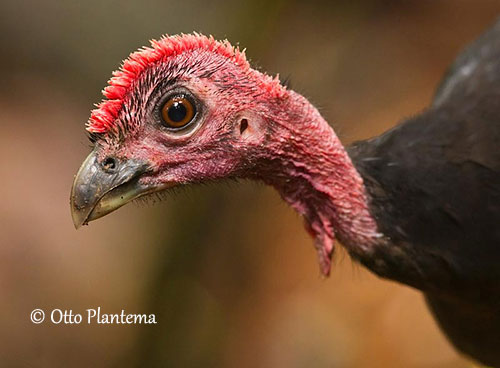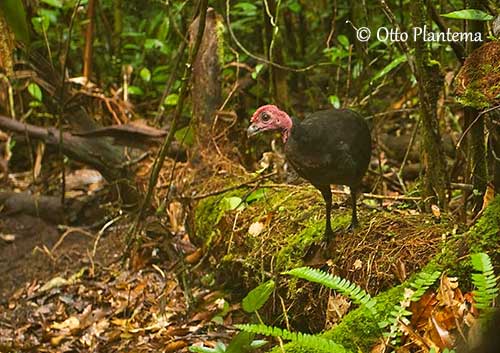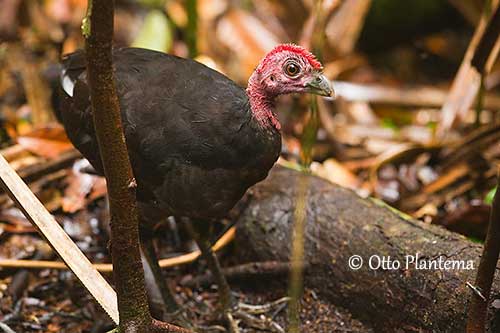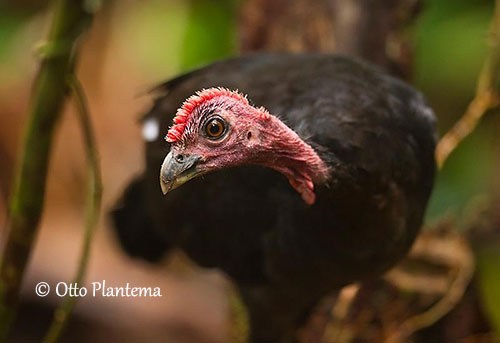
PROTECTION / THREATS / STATUS:
The Waigeo Brushturkey is threatened by reduction of the reserve on Waigeo, and mining program since late 1980s, still being actively pursued. Logging and burning involve the fragmentation of the habitat, rendering some populations isolated. Hunting and introduced dogs are also potential threats. Nest predation by boars may occur locally, and also by the native monitor lizard that is present up to 840 metres of elevation.
The global population is estimated to number at least 980 mature individuals, roughly equivalent to over 1,400 individuals. The population is suspected to be declining at slow or moderate rate.
The Waigeo Brushturkey is currently classified as Endangered.
Fr: Talégalle de Bruijn
Ang: Waigeo Brushturkey - Bruijn's Brushturkey
All: Braunbrust-Buschhuhn
Esp: Talégalo de la Waigeo
Ita: Megapodio di Bruijn
Nd: Bruijns Boskalkoen
Sd: waigeobuskhöna
Photographer:
Otto Plantema
Trips around the world
Text by Nicole Bouglouan
Sources:
HANDBOOK OF THE BIRDS OF THE WORLD Vol 2 by Josep del Hoyo-Andrew Elliot-Jordi Sargatal - Lynx Edicions - ISBN: 8487334156
Birds of New Guinea: Second Edition De Thane K. Pratt, Bruce M. Beehler – Editeur: Princeton University Press, 2014 – ISBN: 1400865115, 9781400865116 – 528 pages
Wikipedia, the free encyclopaedia
Waigeo Brushturkey or Bruijn's Brushturkey
Aepypodius bruijnii
Galliformes Order – Mégapodiidae Family
INTRODUCTION:
The Waigeo Brushturkey or Bruijn's Brushturkey is endemic to Waigeo Island, a West Papuan Island in Indonesia. This rare bird was relocated in 2002, after more than 120 years with no sightings.
It frequents the mountain forests of the island, where the nesting sites can be found between 620 and 930 metres of elevation, on the highest ridges and peaks. It probably feeds on seeds and other plant materials.
Like some other Megapodiidae, it is a mound-builder, and the eggs are naturally incubated within the mound.
The Waigeo Brushturkey is threatened by hunting, predation by introduced dogs and habitat loss, and the species is currently classified as Endangered.
The name of this bird pays tribute to the Dutch navy officer, naturalist and trader Anton August Bruijn.
DESCRIPTION OF THE BIRD:
Biometrics:
Length: 41-46 cm
The Waigeo Brushturkey adult male has dull brown plumage, usually greyer on the upperparts.
On the brown underparts, the breast is mostly chestnut-brown whereas flanks and undertail-coverts are olive-greyish.
On the head, the reddish bare skin of face and neck is embellished with long, pendant wattles. These ornaments are hanging from the neck, with the longest on the foreneck and a tiny one on the chin. The reddish comb is conspicuous during the breeding season.
The male shows a pink nape shield behind the comb, and a pendulous pink throat sac. Both are reduced when the bird is not excited or displaying.
The female has smaller comb. She lacks or has smaller neck wattles.
The immature resembles adult female.

RANGE:
The Waigeo Brushturkey is found on Waigeo Island, NW of New Guinea.
HABITAT:
The Waigeo Brushturkey frequents the forested uplands of the island, an evergreen, stunted cloud forest with epiphytes and ferns, and a dense understorey on infertile soil.
The nest-sites are found between 620 and 930 metres of elevation, on high ridges and peaks, and occasionally in valleys, in dry streams with permanent waterholes, and much rarely down to sea-level.
CALLS AND SONGS: SOUNDS BY XENO-CANTO
The Waigeo Brushturkey is generally silent, but two types of calls are described: a repeated, short clucking note, and a series of raucous cackles. The latter may sometimes be heard when the bird flushes with a whirring noise, in order to escape a danger. This call is probably associated with a threat.
BEHAVIOUR IN THE WILD:
The Waigeo Brushturkey feeds probably mainly on seeds, but these birds are usually omnivorous. Plant materials such as seeds, buds, flowers, leaves and fallen fruits are the main part of the diet. Some invertebrates are also consumed while foraging by walking along on the forest floor, pecking at the vegetation and scratching in among the leaf litter.

The Waigeo Brushturkey is a mound-builder. From some observations, the male is usually alone. It is often silent but territorial, suggesting both polygyny and polyandry mating systems, fairly common among the megapodes. A single male was observed manipulating the active mound, involving the lack of evidence of pair-bonds.
These birds have a unique incubation system. The eggs are incubated by the constant temperature of the mound, especially when the eggs are laid. Construction and maintenance of the mound are performed by the male. The mound requires attention from the owner in order to maintain the temperature equilibrium.
The female must concentrate on building up the resources needed to form the eggs while the male is working on its own. Usually, a female may stay with one male for 3-6 weeks, before to move on to another, fresher mound. The copulation often takes place on top of the mound.
The Waigeo Brushturkey roosts solitary in trees, fairly close to the incubation mound, sometimes just above it.
This species is sedentary, but some altitudinal movements may occasionally occur, following weather conditions, especially droughts.
The Waigeo Brushturkey is technically able to perform short, laboured flights, especially when threatened or alarmed.
From observations, disturbed birds flush low, straight out, over a short distance of 15-30 metres to 80 metres. They typically end up in trees, 8-12 metres above the ground.
The flight is laboured, with rapid, powerful, whirring wingbeats. The bird sometimes loses height, but it shakes and vibrates strongly its body as if struggling to gain height. It does not glide, even while flying down along steep slopes.
This flight is usually accompanied by series of raucous cackles. Once perched in tree, it clumsily leaps upwards along branches, balancing the body with raised wings and tail, and finally flying out of sight between the branches before to disappear.

REPRODUCTION OF THIS SPECIES:
The breeding season probably occurs in May/June, with incubation and females in breeding conditions recorded in May.
The Waigeo Brushturkey is a mound-builder, and the mound is built by the male alone. The mound is first a loose pile of various debris. Then, the shape changes, becoming relatively steep-sided, flat-topped or slightly concave with tamped-down plateau.
During the active phase, the litter is regularly mixed into the mound, or there is an application of an exterior insular layer, making the surroundings scraped clean.
Such mound is about 120 centimetres height and 210 centimetres width at base. It is made with leaves, twigs, sticks and branches. The mound is often placed at base of standing rotten trunk or over a decaying fallen log, and generally under lone, individual conifers of various species.
The egg-laying tends to last 15/45 minutes, sometimes less than 15 minutes if other females are waiting for laying her eggs in the same mound. The size of the clutch may vary, but it is unknown for this species. For information, the female Maleo produces 8/12 eggs per year.
The incubation period is usually very long, depending on the physiological conditions of the mound. It may vary from 44-50 days to 96-99 days, according to the species.
The chicks are very large after such long incubation period. They struggle up to the surface during two hours or a full day (or more). Then, they rest on top of the mound after this effort. They do not receive parental care. They have a fairly full plumage and are able to fly immediately if alarmed. They also feed themselves about 24 hours later. They disperse in the jungle all over the island.
